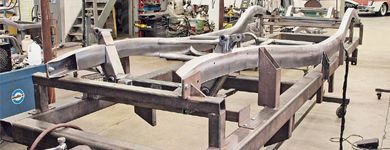
The 1935-40 Ford cars saw little improvement made in the chassis department. Granted, there were numerous differences between the fat-fendered Fords and their predecessors, but there were few changes as far as overall improvements. The addition of hydraulic brakes was one major hurdle achieved, but otherwise the basic concept of cross-spring suspension design under the '35-40 Fords was the same as it had been since the '20s. Until the early '70s, when the Ford Motor Company introduced the Mustang II, very few aftermarket parts were produced for the Deuce's fat brethren. It didn't take hot rodders long to realize that the frontend under the gangly Pony cars were perfectly suited for under their hot rods. The Mustang II frontend was an independent front suspension design with a narrow track width, disc brakes, and rack-and-pinion steering-perfect for replacing the early Ford straight-axle design. It was compact and simple, and replacement parts were available at every parts house.
With the spawn of the Mustang II frontend, and the popularity of the conversion, it was only a matter of time before the aftermarket was off and running with various kits and upgrades. While this was definitely an upgrade from the original straight-axle design, it was far from an end-all solution. Swapping over to disc brakes up front meant changing out the original fruit jar master cylinder to a more modern dual-reservoir master cylinder, which meant modifying the mount and X-member. Most hot rodders who were going through the trouble of upgrading to an IFS were also swapping out the old Flathead for a modern V-8 engine and trans, which meant getting rid of the stock motor and transmission mounts and fabricating new ones in their place, as well as modifications to the radiator. Upgrades to the drivetrain also meant the closed driveline rearend would have to either be converted to open drive or replaced with a stouter modern rearend. Most modern rearends at the time mounted on parallel leaf springs, which meant one more modification to the stock chassis would have to be undertaken. With these points to ponder, it's easy to see how and why the aftermarket chassis industry came to be.
One of the companies making some pretty big waves lately is the Roadster Shop in Elgin, Illinois. They handle every aspect of frame construction in-house from 'rail construction to final fit, assembly, and even build turnkey cars. Their chassis line consists of everything from traditional, straight-axle suspension to contemporary fully independent suspension designs for Model As to Tri-Five Chevys. They recently built a fully independent chassis using Heidt's Hot Rod Shop suspension components for the '35-40 Ford model years. Starting with a set of their bare 'rails, we followed along as Doug Letzow and the crew at the Roadster Shop showed us the hows and whys of their chassis-building technique.